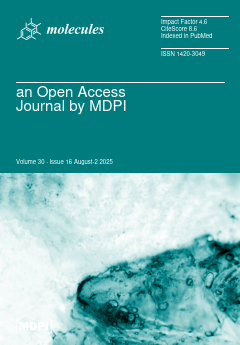Structure–property relationships in imidazolium-based hybrid Sb(III) chlorides provide critical guidance for designing high-performance materials. Three zero-dimensional metal halides, namely, [C
3mmim]
2SbCl
5 (
1, [C
3mmim]
+ = 1-propyl-2,3-dimethylimidazolium), [C
5mmim]
2SbCl
5 (
2,
[...] Read more.
Structure–property relationships in imidazolium-based hybrid Sb(III) chlorides provide critical guidance for designing high-performance materials. Three zero-dimensional metal halides, namely, [C
3mmim]
2SbCl
5 (
1, [C
3mmim]
+ = 1-propyl-2,3-dimethylimidazolium), [C
5mmim]
2SbCl
5 (
2, [C
5mmim]
+ = 1-pentyl-2,3-dimethylimidazolium), and [C
5mim]
2SbCl
5 (
3, [C
5mim]
+ = 1-pentyl-3-methylimidazolium), are synthesized by ionothermal methods. These compounds exhibit markedly distinctly photophysical properties at their optimal excitation wavelengths. Structural analyses reveal that elongated alkyl chains in compounds
2 and
3 increase Sb–Sb distances compared to that in
1, effectively isolating [SbCl
5]
2− units, suppressing inter-center energy transfer, and reducing non-radiative transitions, thereby enhancing the photoluminescence quantum yield (PLQY). Furthermore, methyl substitution at the C2-position of the imidazolium ring in compounds
1 and
2 induces asymmetric coordination environments around the [SbCl
5]
2− emission centers, leading to pronounced structural distortion. This distortion promotes non-radiative decay pathways and diminishes luminescent efficiency. Furthermore, temperature-dependent spectroscopy analysis and fitting of the Huang–Rhys factor (
S) reveal significant electron–phonon coupling in compounds
1–
3, which effectively promotes the formation of self-trapped excitons (STEs). However, compound
1 exhibits extremely high
S, which significantly enhances phonon-mediated non-radiative decay and ultimately reduces its PLQY. Overall, compound
3 has the highest PLQYs.
Full article






